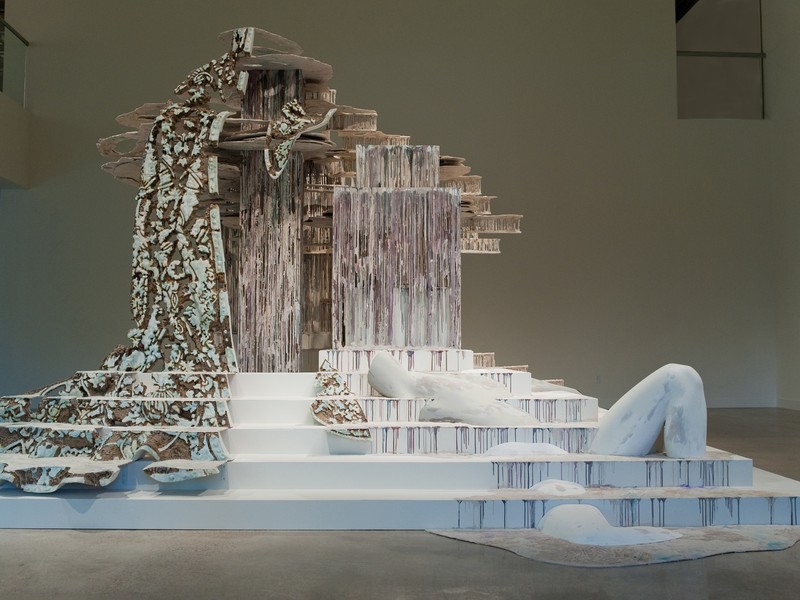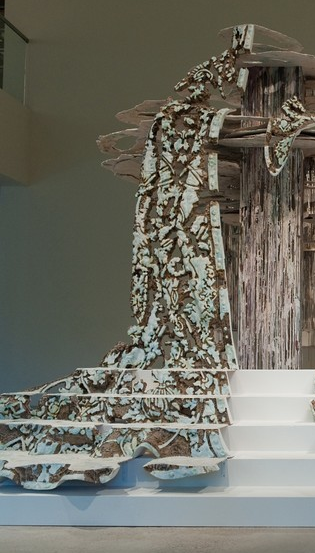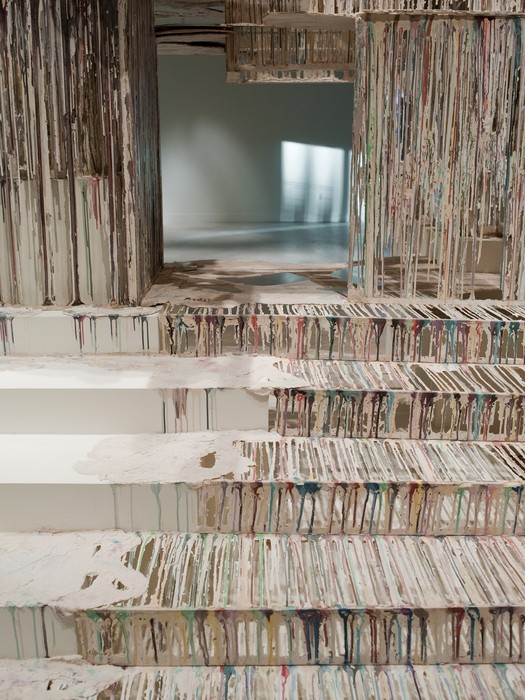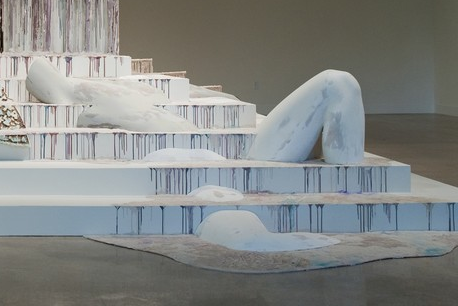
Image Credit: Sandy Carson, taken from CultureMap Austin
For those of us interested in architectural sculpture, the last few months in Austin (especially on the UT campus) have felt like gifts from the art gods. I’ve already written about one exhibition (the recently-closed El Anatsui: When I Last Wrote to You about Africa show at the Blanton Museum of Art). This month ushered in a second sculptural exhibition. New York sculptor Diana Al-Hadid’s Suspended After Image, a site-specific installation at UT’s Visual Arts Center’s Vaulted Gallery, is a feat of texture and height. As a fantastic example of architectural art, Al-Hadid’s most recent work for the VAC asks viewers to circumambulate the sculpture and ponder the relationship between memory, built objects, and humanity.

Image Credit: Sandy Carson (cropped)
Memory inspired the entire installation. Al-Hadid was stirred to create her sculpture “Suspended After Image” after seeing a Gothic painting of the Visitation which featured an intricate cloak. Working with twelve UT art assistants, Al-Hadid turned her memory of a two-dimensional painting into a three-dimensional structure. “Suspended After Image” has a certain sinuousness to it—a river of faux-fabric permanently flows over more than half of the sculpture. I’m tempted to think that the sumptuous river of cardboard, wood, plaster, and metal evokes the way that memory works. Much as fabric folds and rivers flow, we remember in spurts and starts. In a recent article on Al-Hadid’s installation at the VAC, Austin blogger Michael Graupmann reviews the artist’s creation process: “images she sees often get stuck in her mind, (‘made sacred’) and stay with her until she transforms them through her work.” The curvy form of Al-Hadid’s piece seems to mimic its creation process.

Image Credit: Sandy Carson, taken from CultureMap Austin
And yet there is also a sharp jaggedness to the whole thing—paint globs create skyscraper-like structures that rise out of the ground. It’s safe to say that “Suspended After Image” is a work that mimics our built environment, as Al-Hadid’s creations often involve architectural tools and methods. For this particular piece, Al-Hadid used a 3D modeling program and CNC router to plan its structure. Intricate lattices and elaborate stairs need to be modeled, whether they are used for art or architecture.

Image Credit: Sandy Carson (cropped)
And behind every architectural design is a person. Al-Hadid’s sculpture doesn’t allow its viewers to forget the human element in architecture and art. While walking around the sculpture (which urges us to do so from multiple viewpoints, even from above in the VAC’s Mezzanine), we’re surprised that the artist planned for every angle to be seen by an ambulatory audience. The most surprising part of Al-Hadid’s “Suspended After Image” is the supple plaster body that is either disappearing into or emerging from the stairs at the bottom of the sculpture. Is the built environment oppressing this body into oblivion? Is it growing human loins? I’m unsure myself. But at least the human (in the sculpture and outside of it) isn’t forgotten.
See Diana Al-Hadid’s “Suspended After Image” yourself at the Visual Arts Center until March 10th, when another Artist-in-Residence piece will take its place.




Recent comments
2 years 29 weeks ago
2 years 44 weeks ago
2 years 44 weeks ago
2 years 50 weeks ago
3 years 4 weeks ago
3 years 4 weeks ago
3 years 4 weeks ago
3 years 6 weeks ago
3 years 6 weeks ago
3 years 6 weeks ago